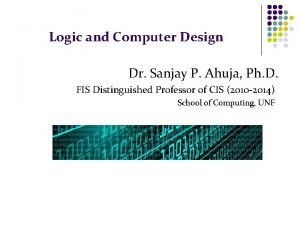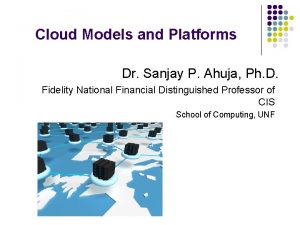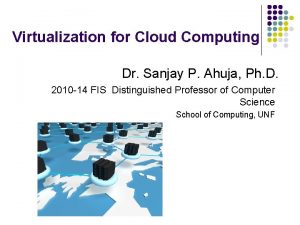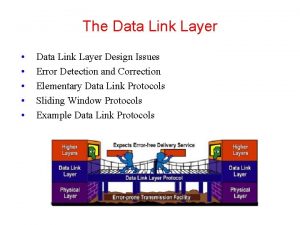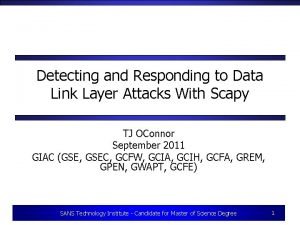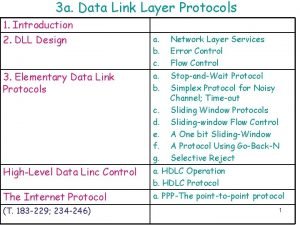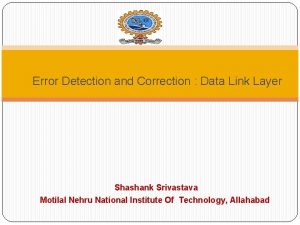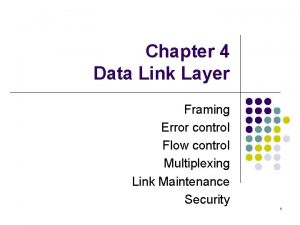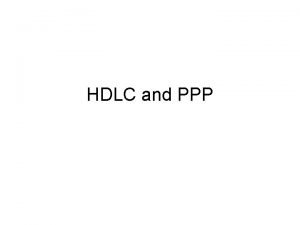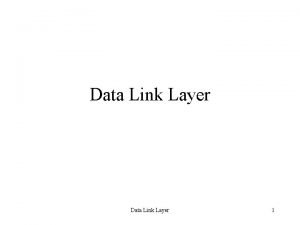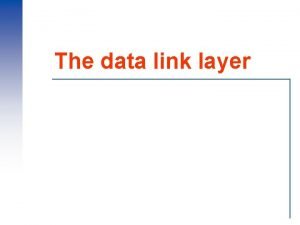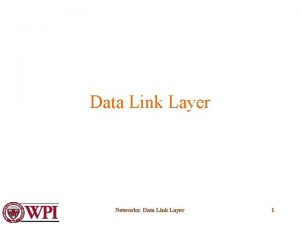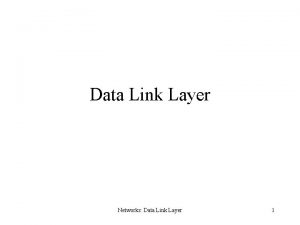Data Link Layer 1 Dr Sanjay P Ahuja














- Slides: 14

Data Link Layer - 1 Dr. Sanjay P. Ahuja, Ph. D. Fidelity National Financial Distinguished Professor of CIS School of Computing, UNF

Introduction l Deals with algorithms used to achieve a reliable, efficient communication between two adjacent machines, i. e. connected by a point-to-point link. The Data Link Layer provides a service to the Network Layer l Limitations to consider: l l Errors in bit transmission Channels have only a finite data rate Machines have a finite processing speed Functions of the Data Link Layer: l l l Framing (how to group bits of the physical layer into frames) Error Control Flow Control

Framing l Data Link layer accepts packets from the network layer, and encapsulates them into frames that it sends using the physical layer; reception is the opposite process.

Service Possibilities l Unacknowledged connectionless service l l l Acknowledged connectionless service l l l Frame is sent with no connection / error recovery Ethernet is example Frame is sent with retransmissions if needed Example is 802. 11 Acknowledged connection-oriented service l Connection is set up; rare

Framing – Byte Count l Frame begins with a count of the number of bytes in it. l Simple, but difficult to resynchronize after an error

Framing – Start and End Flags with Bit Stuffing l l This allows frames to contain an arbitrary number of bits. Each frames begins and ends with a special flag, 01111110. Whenever the sender’s data link layer encounters 5 consecutive 1’s in the data, it automatically stuffs a 0 bit into the outgoing bit stream. This is called bit stuffing. When the receiver sees 5 consecutive 1’s followed by a 0, it automatically destuffs the 0 bit. Example: Original Data Stream: 0110 11111 01101 Data on the line: 0110 11111 0 01101

Error Control l Deals with determining that an error has occurred and correcting errors. l l l Requires errors to be detected at the receiver Typically retransmit the unacknowledged frames after timer expires on sending side Timer protects against lost acknowledgements

Error Control – Parity Bit l A parity bit is appended to the end of each word in the frame. The value of this bit is selected so that the word has an even number of 1’s (even parity) or an odd number of 1’s (odd parity). l Consider letter G in ASCII: For odd parity: For even parity: l l l 1110001 1 1110001 0 1110001 At the receiving end it is checked if the number of 1’s is still odd (for odd parity, else an error is said to have occurred. Drawback: If any two bits (or an even number of bits) are in error, then this mechanism fails to detect an error. So success rate in catching errors is only 50% Example if G with odd parity is received as: in error) 1 0010001 (2 nd and 3 rd bits are

Error Control – Longitudinal Redundancy Check (LRC) l l To improve on the 1 st mechanism, a second set of parity are used. The frame is viewed as a block of characters arranged in 2 D. To each character is appended a parity bit, as in the 1 st mechanism. In addition, a parity bit is generated for each bit position across all characters (vertically). So an additional character is generated. If two bits are in error in a character, this is detected. But some patterns still go undetected. E. g. if bits 1 and 3 are in error in both char 1 and char 5. Success rate in detecting errors is about 75%.

Error Control – Cyclic Redundancy Check (CRC) Procedure: l 1. Given a k-bit frame or message, the transmitter generates an n-bit sequence, known as the Frame Check Sequence (FCS), so that the resulting frame, consisting of k+n bits, is exactly divisible by some predetermined number. l 2. The receiver then divides the incoming frame by the same number and, if there is no remainder, assumes there was no error.

Error Control – Cyclic Redundancy Check (CRC) Define: T = (k + n) bit frame to be transmitted, with n<k M = k-bit message, the first k-bits of T F = n-bit FCS, the last n-bits of T P = pattern of (n+1) bits; this is the predetermined divisor (Note: the FCS or remainder is always 1 bit less than the divisor, P)

Error Control – Cyclic Redundancy Check (CRC) Example: Message, M = 1010001101 (10 bits) Pattern P (divisor) = 110101 (6 bits) FCS, Remainder (R) = to be calculated (5 bits) The message is multiplied by 25 (to shift it 5 bits to the left and padded with 0 s): 1010001101 00000 This product is now divided by P.

Error Control – Cyclic Redundancy Check (CRC) 110101 101000110100000 110101 111011 110101 1110101 111110 110101 101100 110101 110010 110101 1110 1 0 0 0 + 1 1 0 1 - 1 1 1 0 1 Remainder, R (FCS) = 01110 since remainder has to have 5 bits. The transmitted message then is 101000110101110. The receiver divides the message it receives by the same divisor, P, and if the remainder is 0, it assumes there were no errors during transmission.

Error Control – Cyclic Redundancy Check (CRC) l We can turn a message into a polynomial (with bits as coefficients) simply by using the bits as coefficients, so message M=11100011 becomes: M(x)=1⋅x 7 + 1⋅x 6 + 1⋅x 5 + 0⋅x 4 + 0⋅x 3 + 0⋅x 2 + 1⋅x+ 1 = x 7 + x 6 +x 5 +x+1 l l l The CRC-polynomial P=110011 similarly becomes P(x)=x 5 +x 4 +x+1. Notice how the exponents of x simply act as place holders in the sense that the bit in position i is simply the coefficient of the power xi. Standard P(x) used are:
 Sanjay ahuja md
Sanjay ahuja md Sanjay ahuja amazon
Sanjay ahuja amazon Dr sanjay ahuja
Dr sanjay ahuja Sanjay ahuja md
Sanjay ahuja md Data link layer design issues
Data link layer design issues Materi data link layer
Materi data link layer Deauth attack
Deauth attack Pengertian
Pengertian Switching in data link layer
Switching in data link layer Data link layer protocols
Data link layer protocols Utopian simplex protocol
Utopian simplex protocol Error detection and correction in data link layer
Error detection and correction in data link layer Data link layer design issues
Data link layer design issues Data link layer framing
Data link layer framing Hdlc categories
Hdlc categories
